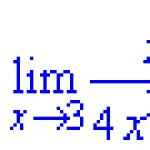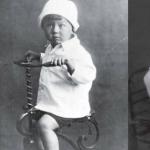The topic of English numerals is quite complex, since the formation of English numerals differs from the formation of Russian ones. There are rules, and there are exceptions, and both have their own peculiarities. Let's look at English numbers with transcription and Russian pronunciation, let's look at vivid examples and let's focus on exceptions. Go ahead for new knowledge!
Numbers in English language are formed in different ways. Numerals from 1 to 10 have some rules of formation, from 13 to 20 - others. Tens, hundreds and thousands also have peculiarities of education.
Features of the formation of numerals from 1 to 12
The table below shows the numerals from 1 to 12 with transcription, Russian pronunciation and examples:
| 1 | one | one | |
| 2 | two | [ˈtuː] | that |
| 3 | three | [θriː] | sri |
| 4 | four | odds | |
| 5 | five | five | |
| 6 | six | syx | |
| 7 | seven | [ˈsevn] | s'even |
| 8 | eight | eith | |
| 9 | nine | nain | |
| 10 | ten | heating element | |
| 11 | eleven | [ɪˈlevn̩] | il'even |
| 12 | twelve | tU'elv |
- We wanted one cake, two bananas ang eight apples => We wanted one cake, two bananas and eight apples.
- We need to buy avocado fot this recipe. Or better two ones => For this recipe we have to buy an avocado. Or better yet, two.
- Three kilos of meat, four big tomatoes, five eggplants and garlic will make this evening much more better. I will prepare very delicious dish by my own recipe! => Three kilograms of meat, four large tomatoes, five eggplants and garlic will make the evening much better. I will prepare a very tasty dish according to my own recipe!
- Eleven foxes and twelve wolves were seen on this week at this place => Eleven foxes and twelve wolves were seen this week at this place.
Features of the formation of numerals from 13 to 20
| 13 | thirteen | [θɜː’tiːn] | sert'in |
| 14 | fourteen | [ˌfɔː’tiːn] | fort'in |
| 15 | fifteen | [ˌfɪf’tiːn] | fifty'in |
| 16 | sixteen | [ˌsɪk’stiːn] | sykst'in |
| 17 | seventeen | [ˌsev(ə)n’tiːn] | Seventh'in |
| 18 | eighteen | [ˌeɪ’tiːn] | eit'in |
| 19 | nineteen | [ˌnaɪn’tiːn] | night'in |
The table shows that numerals from 13 to 19 (inclusive) are written according to the same rules; a particle is added to the cardinal number (one, two, three) –teen. And do not confuse cardinal numbers with ordinal numbers! in English they are formed in a completely different way!
On a note! It must be remembered that every rule has exceptions. In this case, the exceptions will be the numerals 13 and 15. Their roots three and five will have a modified form:
- Three => thirteen
- Five => fifteen.
Not threeteen/fiveteen!!!
Some examples:
- Seventeen girls were seen at this party while only eight boys came. — Seventeen girls were seen at the party, while only eight guys came.
- Seventeen pieces of cake were given to all those children. — All these children were given seventeen pieces of pie.
- There is a lot of fish in this river. Nineteen kinds were known 5 years ago. — There are a lot of fish in this river. Five years ago, nineteen species were known.
Tens of English numerals
| 20 | twenty | [ˈtwenti] | tU'enti |
| 30 | thirty thirty | [ˈθɜːti] | S'yorti |
| 40 | forty | [ˈfɔːti] | f'orti |
| 50 | fifty | [ˈfɪfti] | f'ifti |
| 60 | sixty | [ˈsɪksti] | s’yksti |
| 70 | seventy | [ˈsevnti] | s'eventi |
| 80 | eighty | [ˈeɪti] | ‘hey |
| 90 | ninety | [ˈnaɪnti] | n'ainti |
The table clearly shows that tens of numbers are formed using a particle (suffix) –ty. These numerals are derivatives of cardinal ones, but you also need to add the suffix –ty.
Important! Remember that when forming the numbers 20,30, 40 and 50, the root of the cardinal digits, which serve as the basis for the formation of tens, will change:
- two – 20 twenty [ˈtwenti]
- three – 30 thirty [ˈθɜːti]
- four – 40 forty [ˈfɔːti]
- five – 50 fifty [ˈfɪfti]
And one more nuance: the number 80 [ˈeɪti] is characterized by the absence of repetition of the letter t: eight (eight) = eighty(eight+ty =eightty).
Examples:
- Thirty exotic animals were needed to make the idea of the movie complete => Thirty exotic animals were needed to make the idea of the movie complete.
- Sixty soldiers will come on parade in front of the palace => Sixty soldiers will come to the parade that will be in front of the palace.
- Fifty of them knew the road but only thirty agreed to follow us => Fifty of them knew the road, but only thirty agreed to follow us.
As for the stress of numerals that are formed with the help of –ty, then everything is simple - stress Always will be on the first syllable.
Reference: It happens that beginning students find it difficult to separate numerals with –ty and –teen in colloquial speech. And here stress comes to the rescue - if it is on the first syllable, then 100% we are dealing with tens of numerals.
Basics: How numbers are formed in English
When studying the formation of English numbers, it is important to remember that numbers from 1 to 12 are simple cardinal numbers. Their task is to indicate the number of objects. Such numerals consist of one word. It is very important to remember the spelling of the first twelve digits, since they are the basis for the formation of all other digits - from thirteen to a billion.
How to pronounce numerals that are formed by adding the particle –teen? Here you need to be very careful => the pronunciation of numerals (English numbers) will have two stresses: on the first and second syllable. At the same time, we immediately note that the stresses will not be equal in strength. One of them will be secondary, and the other will be primary.
For example, how do you pronounce thirteen? From the transcription of [ˌθɜːˈtiːn] it is clear that the word has two stresses. The bottom line indicates secondary stress, the top line indicates primary stress. The same goes for fourteen [ˌfɔːˈtiːn] and fifteen [ˌfɪfˈtiːn]. There are also two stresses here – main and additional.
What to do to avoid making mistakes with pronunciation? To do this, you should always look at the transcription. Each numeral, like any other word, should be studied according to the following scheme: transcription - translation - the presence of several meanings.
Note! In some dictionaries, the stress of numerals is determined by the presence (absence) of a noun after it. For example, if a numeral is next to a noun, then the stress falls on the first syllable =>
- fifteen rivers [ˈfɪftiːn ˈrɪvər z]
- sixteen cats [ˈsɪkstiːn ˈkæts]
But! If a numeral stands alone in a sentence, without a noun, then the stress falls on the second syllable (on the suffix –teen):
- fifteen
- sixteen
Examples:
- Fifteen cats were sold this week (emphasis is on the first syllable) => Fifteen cats were sold this week
- How many cats were sold this week? – Fifteen (emphasis on the suffix –teen) => How many cats were sold this week? - Fifteen.
How many? - How many?
How many? - How many?
Using cards we learn ordinal numbers.
One two three four five...
We work with cards as usual. At first, both the number and the word in English, and the transcription, and the translation :) are on the same side.
Once the basic numbers have been learned, the cards can be folded and the halves glued together. As a result, there is a number on one side and a word in English on the other.
Cards with the first ten numbers can be used to study two-digit, three-digit, and so on numbers.
 Numbers from 0 to 12 are “prime” numbers.
Numbers from 0 to 12 are “prime” numbers.
The numbers of the second ten from 13 to 19 and numbers denoting an integer number of tens are classified as “derived” numerals.
Numbers 13 to 19 are obtained using the suffix teen, read as "tin".
By the way, do you know why in England teenagers are called teenagers?
This comes from the words teen and age - the age at which the number of years ends with teen. That is, teenagers are teenagers aged 13 to 19 years.
Numbers, denoting an integer number of des. I tkov, 20, 30, 40 ... 90 are formed using the suffix ty

Well, numbers denoting tens with ones, starting from the second ten, belong to “composite” numerals and are written with a hyphen. Eg, fifty-one - fifty-one. 

In English words hundred- one hundred, thousand- thousand, million- million are nouns, so if they are used in singular they must be preceded by an indefinite article a or numeral one, For example: a hundred or one hundred- (one hundred.

For additional English classes, it is not at all necessary to hire an expensive tutor. It is quite possible to use online services for learning English. You will find one of these sites by following the link. The site offers not only tutorials and theory, but also a variety of exercises, tests, dictations, and tests.
To get started, you can register for free.
Download archive: (downloads: 668)
Dear readers!
All materials from the site can be downloaded absolutely free. All materials have been scanned by antivirus and do not contain hidden scripts.
The materials in the archive are not marked with watermarks!
The site is updated with materials based on the free work of the authors. If you want to thank them for their work and support our project, you can transfer any amount that is not burdensome to you to the site’s account.
Thank you in advance!!!
At almost every level, English language learners have to deal with numbers and counting. On entry level Children learn to count in English from one to five, then from one to ten. Next comes the second ten and the count to one hundred.
And this is not surprising, because numbers surround us everywhere: each house has its own number, several pigeons or sparrows sit in flocks on the street, to prepare a delicious dish you need to use several fruits, vegetables or other products. Therefore, there are many fun exercises for learning numbers in English, from playing Bingo (with numbers) to counting familiar objects in the classroom.
At the same time, you can introduce children to numbers and counting not only in these ways, but also with the help of funny songs.
The five selected songs in English have a simple and clear rhythm that even children 2-3 years old can follow. In addition to the good mood that they will create during an English lesson, children will also be able to remember English numbers from one to ten or even up to 20.
And to make memorization more effective, some songs suggest counting objects in reverse order.
Five little monkeys
The melody of this song is easy for a child to reproduce, and the repeated constructions will help reliably fix English numbers from one to five in memory. In addition, the story of the five naughty monkeys is usually a favorite among children. And she also helps them understand what will happen in the event of such disobedience!
If desired, the song can be used for a short warm-up during class. Children can stand apart from each other or make a big circle and jump together holding hands. In the picture below you can see what movements can accompany the words of the song.

After the next monkey “fell,” we bend one finger on our hand and raise our palm not with five fingers, but with four (with three, with two, with one).
Can you count?
The cheerful characters of the song (the hen and her chicks) to the music count in English those animals and objects that they meet on the way. At the same time, they pronounce the numbers from one to ten several times:
One, two, three,
Four, five, six.
And at the end of the video, the chicken and her babies count everything in reverse order - from ten to one.
In addition, the animals in the song repeat common interrogative constructions several times:
Do you know how to count? – Yes, I know how to count.
Can you count from 1 to 10? – I can count from 1 to 10.
Counting to the music
Although this counting rhyme cannot be called a song as such, it will be interesting for kids to get acquainted with the shape and name of various numbers (from 1 to 20) to the music. In order to remember words better, you can use not only visual and auditory memory, but also tactile memory, for example, by beating out a musical rhythm with your palms (against each other) or with a pencil (on the table).
Ten little airplanes
In the energetic song about ten airplanes, the counting in English is first done from 1 to 10, and then in reverse order, which helps both memorize individual numbers and train the child’s voluntary attention.
You can also invite children not only to watch the video, but also to move along with the airplanes: take a step every time a new character flies out, while spreading their arms to the sides, depicting an airplane.
How many leaves do you see?
Although the song asks children to count only three leaves, it is very convenient to practice the structure of “How many?” . And after the child remembers the song well, it will be possible to cut out the required number of leaves from paper, color them, and then count them. So, while singing the song, you can also repeat the different colors in English with your baby.
Baby! Don't be afraid to learn something new! If you know numbers in Russian, then you will definitely know how they are written and pronounced in English. In that distant country of England, numbers are written and pronounced a little differently, they are not at all complicated. Now let's look a little at the history of numbers.
A short course on the history of numbers
There used to be primitive people, they explored this world, just like you do now. And they noticed that they had five fingers on each hand. Look at your hand now. Do you see? You have five fingers. And the second hand has five fingers. And if you add them up, it turns out that you have ten fingers on both hands. People realized that numbers could be written down somehow, for example on stones, because there were no pens and pencils then.
You may ask, why should I write it down? Well, you can, for example, write down a number on paper and remember that they bought you two ice creams yesterday and now you already need three ice creams. Now we will stop at the history course and move straight to the numbers.
Table of numbers from 1 to 20
| Number | Number name in English | Transcription of English numerals | Approximate pronunciation of an English number in Russian | The name of the English number in Russian |
| 0 | zero | [´ziərəu] | ´zierou | zero |
| 1 | one | one | one | |
| 2 | two | that:* | two | |
| 3 | three | [θri:] | sri:** | three |
| 4 | four | fo: | four | |
| 5 | five | five | five | |
| 6 | six | syx | six | |
| 7 | seven | sevn | seven | |
| 8 | eight | eith | eight | |
| 9 | nine | nain | nine | |
| 10 | ten | ten | ten | |
| 11 | eleven | i´levn | eleven | |
| 12 | twelve | tuelv | twelve | |
| 13 | thirteen | [θə:´ti:n] | sho´ti:n** | thirteen |
| 14 | fourteen | fo´ti:n | fourteen | |
| 15 | fifteen | fifty:n | fifteen | |
| 16 | sixteen | syx´ti:n | sixteen | |
| 17 | seventeen | sevn´ti:n | sevn´ti:n | seventeen |
| 18 | eighteen | hey:n | eighteen | |
| 19 | nineteen | nain´ti:n | nineteen | |
| 20 | twenty | [´twenti] | tu´enti | twenty |
Want to learn more numbers? For example.
Children first begin to learn a foreign language when they are still kindergarten. Study simple words, which are found in Everyday life. Every first grader should know how to count within ten in English. This is a basic program that a child must master when entering school. Numbers in English can be learned not only easily, but also in a fun way. Today, many interesting ways and methods have been invented for this.
Learning numbers from 1 to 19
English numbers from 1 to 100 are easy to count and learn if you approach the learning process with ingenuity. To learn faster new language, you need to understand the invoice generation process. At the initial stage, it is worth learning only 12 numbers, which will help you master the entire grammatical series. Every schoolchild and adult knows them. Therefore, any parent can teach their child with ease.
First, you need to memorize the numbers from 1 to 12. A special table will help you do this.
| Number | Name in Russian | Name in English + how to spell the word | |
| 1 | One | one | One |
| 2 | Two | twu | That |
| 3 | Three | three | Fries |
| 4 | Four | Four | Fo |
| 5 | Five | five | Fife |
| 6 | Six | six | Syks |
| 7 | Seven | seven | Sevn |
| 8 | Eight | eight | Eyt |
| 9 | Nine | nine | Nine |
| 10 | Ten | ten | Ten |
| 11 | Eleven | eleven | Elevn |
| 12 | Twelve | twelve | tuelv |
Presented English number series, as a rule, is taught in poetic form, so it is easy to remember.
Counting from 13 to 19, knowing the previous numbers by heart will be easy. To do this, you need to learn how to compose a number series yourself using learned numbers.
To get 13, you need to add the suffix teen (teen) to the number 3, you get three (free) + teen (teen) = thirteen (fetin). The same rule applies to the numbers five and four:
- four (fo) + teen (tin) = fourteen (photin) - 14;
- five (fife) + teen (tin) = fifteen (fiftin) - 15.
This series can be continued until 19: 16 - sixteen, 17 - seventeen, 18 - eighteen, 19 - nineteen. If a child understands the process of forming numbers from 1 to 20, English will become the child’s favorite language, which is not at all difficult to learn on your own or with the help of your parents.
Making tens
Tens in English are just as interesting to learn as other numbers in counting. Because they are formed according to the same pattern as the previous numbers. Round numbers are obtained by adding the suffix ty. For example, to understand how to pronounce and write 20, 30, 40, 50, you need:
This creates a table of round tens.
| Number | Name in Russian | Approximate pronunciation in Russian | Title in English |
| 20 | Twenty | Twenty | Twenty |
| 30 | Thirty | Soti | Thirty |
| 40 | Fourty | Foti | Forty |
| 50 | Fifty | Fifty | Fifty |
| 60 | Sixty | Sixty | Sixty |
| 70 | Seventy | Seventi | Seventy |
| 80 | Eighty | Ayti | Eighty |
| 90 | Ninety | Ninety | Ninety |
It is worth remembering how the numbers 50, 40, 30, 20 are written and pronounced. These are exception words. During their formation, the root is modified.
Getting the rest of the numbers from one to one hundred is also not difficult. Any schoolchild can do this if he understands the technology of their education. An example can be given using numbers 54 and 45:
- 54 is made up of fifty and four, so in English language it will sound like fifty (50) + four (4) = fifty-four (fifty-fo);
- 45 consists of forty (forty) and five (five), resulting in forty-five (forty five).
As shown above, the number is made up of tens and ones, which is closely related to the Russian language - 20 (twenty) + 5 (five) = 25 (twenty-five). IN native language the numbers are readable. This makes the learning process easier.
Any kid will be able to understand the pattern of creating the numbers four, five, ten, twenty-four, etc. up to 100 if his parents help him and guide him. Already in primary school he will have extensive acquaintance with English and British pronunciation and their differences. In the first grades, children are already learning how to write and pronounce numbers up to 100. Therefore, it is extremely important to help the child master before entering school. foreign language excellently.




